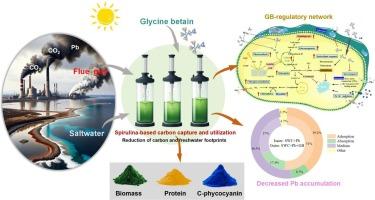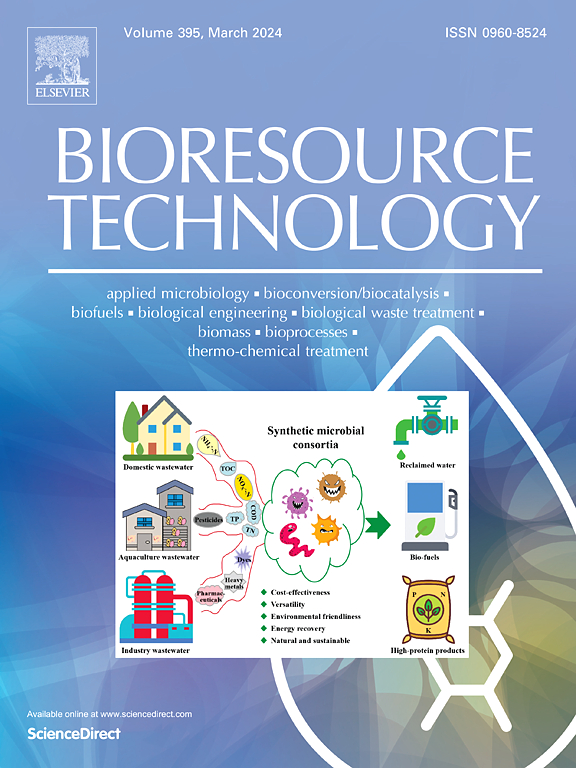在高二氧化碳和高盐度条件下利用甘氨酸甜菜碱增强螺旋藻对铅的耐受性,以实现可持续碳捕获。
IF 9.7
1区 环境科学与生态学
Q1 AGRICULTURAL ENGINEERING
引用次数: 0
摘要
基于微藻的碳捕集与利用(CCU)提供了一种前景广阔的负排放技术,它可以吸收二氧化碳并产生有价值的生物质。然而,工业烟气中的重金属污染物会影响固碳效率和生物产品质量。研究人员将螺旋藻作为二氧化碳封存的模式生物,使用改良的扎鲁克培养基,结合盐胁迫和渗透保护剂,以提高 15% CO2 条件下的生物量产量。这种方法既提高了生物量产量(380.83 mg L-1 d-1),又增强了对铅毒性的抗性。分析评估显示,补充甘氨酸甜菜碱(GB)可大幅减少铅的积累,使细胞外和细胞内的铅含量分别降低了39.7%和60.7%。细胞外溶解有机物也明显减少。此外,转录组分析证实,GB 处理加强了渗透胁迫反应并抑制了金属离子的转运。这些发现提高了基于微藻的 CCU 技术的可行性,标志着可持续藻类生物技术取得了重大进展。本文章由计算机程序翻译,如有差异,请以英文原文为准。

Enhancing lead tolerance in spirulina using glycine betaine under high CO2 and salinity for sustainable carbon capture
Microalgae-based carbon capture and utilization (CCU) offers a promising negative emission technology that absorbs CO2 and generates valuable biomass. However, heavy metal pollutants in industrial flue gases can compromise carbon sequestration efficiency and bioproduct quality. Spirulina was investigated as a model organism for CO2 sequestration, using a modified Zarrouk’s medium to integrate salt stress and an osmoprotectant to boost biomass yield under 15 % CO2. This approach enhances both biomass yield (380.83 mg L–1 d–1)and resistance to lead toxicity. Analytical assessments revealed that glycine betaine (GB) supplementation drastically reduced lead accumulation, decreasing the extracellular and intracellular contents by 39.7 % and 60.7 %, respectively. A notable decrease in extracellular dissolved organic matter was also observed. Furthermore, transcriptomic analyses confirmed that GB treatment strengthened osmotic stress responses and suppressed metal ion transport. These findings enhanced the feasibility of microalgae-based CCU technologies, marking significant progress in sustainable algal biotechnology.
求助全文
通过发布文献求助,成功后即可免费获取论文全文。
去求助
来源期刊

Bioresource Technology
工程技术-能源与燃料
CiteScore
20.80
自引率
19.30%
发文量
2013
审稿时长
12 days
期刊介绍:
Bioresource Technology publishes original articles, review articles, case studies, and short communications covering the fundamentals, applications, and management of bioresource technology. The journal seeks to advance and disseminate knowledge across various areas related to biomass, biological waste treatment, bioenergy, biotransformations, bioresource systems analysis, and associated conversion or production technologies.
Topics include:
• Biofuels: liquid and gaseous biofuels production, modeling and economics
• Bioprocesses and bioproducts: biocatalysis and fermentations
• Biomass and feedstocks utilization: bioconversion of agro-industrial residues
• Environmental protection: biological waste treatment
• Thermochemical conversion of biomass: combustion, pyrolysis, gasification, catalysis.
 求助内容:
求助内容: 应助结果提醒方式:
应助结果提醒方式:


